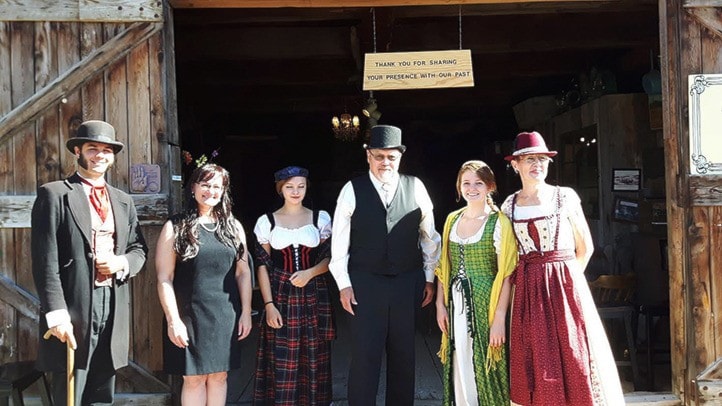The fashion scene in Clinton
On Thursday, August 25 more than 50 people gathered at the Clinton Museum Government Stables to enjoy 100 years of period clothing.
Chris Linton from the Historic Hat Creek Ranch led the show with her “cowgirl to the belle of the ball” transformation. She treats guests at the ranch to the same show, but with a few differences. At the ranch she arrives by stagecoach, but she had to enter on foot in Clinton.
She explained (in an exaggerated western drawl) that visitors expect to see and hear the “wild west” as portrayed in movies. She shed the handgun and drawl (and several pieces of clothing) to show what women wore back in the 1860s. Everything from the bloomers, chemise, corset, petticoats, bustle, over-skirt, and top were put on to show how a lady would have dressed long ago.
Following Linton’s demonstration and a brief intermission, the crowd was treated to a show of fashion through the ages as would have been seen in Clinton. The fashions were modelled by Daniel Homburg of Hat Creek Ranch, museum hostess Bernice Weihs-Anderson, and museum summer students Madelyn Johnston and Becky Rosette.
From the hoop skirts and bowler hat and tails of the 1860s through the fashions of the early 1900s and the war years, to the 1930s, 1950s, and 1960s, one was taken on a time travel tour of the fashions of the ages.
It was interesting to see how women’s fashion underwent so much change, from hoop skirts and hobble skirts (yes, there really was such a thing) to the flapper era, and from poodle skirts to the miniskirts of the 1960s.
Men’s fashion didn’t appear to undergo quite as much change. If one looked at how cowboys dressed in the 1860s and compared that with what they wear now, there would be very little difference. Jeans are still worn, although originally jeans were brown, not blue.
While women were wearing poodle skirts, young men wore jeans and white t-shirts (with the sleeves rolled up). When one wanted to impress a young lady’s parents, a young man would don a cardigan with the name of his school on it.
The three ladies also displayed period costumes of their ancestors from Scotland, Ireland, and Germany; three of the many nationalities that helped make B.C. what it is today. The models did an excellent job of displaying the fashions as Linton explained what they were wearing.
Many thanks to the Museum Society and Historic Hat Creek Ranch for the fun afternoon. Although there was no charge for this unique look at Clinton’s past, donations for the museum’s ongoing wagon shed project were gratefully accepted.
